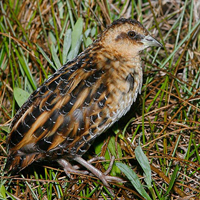Yellow rail
Scientific name: Coturnicops noveboracensis

Cover photo credit: Brian E. Small
Status
Special Concern
“Special Concern” means the species lives in the wild in Ontario, is not endangered or threatened, but may become threatened or endangered due to a combination of biological characteristics and identified threats.
Date added to the Species at Risk in Ontario List
The Yellow Rail was already assessed as a species of special concern when the Endangered Species Act took effect in 2008.
What it looks like
The Yellow Rail is a small quail-like marsh bird, about 13 to 18 centimetres long. It has a short yellow or blackish bill and a very short tail. The chest and face are buff-yellow, and it is distinguished from other rails by the yellowish and black streaks on its back and white wing patches. It has a dark crown and dark stripe through its eyes.
Where it lives
Yellow Rails are secretive birds and live deep in the reeds, sedges, and marshes of shallow wetlands, where they nest on the ground. The marshy areas used by Yellow Rails have an overlying dry mat of dead vegetation that is used to make roofs for nests.
Where it’s been found in Ontario
The Yellow Rail ranges across much of central Canada and parts of the northern United States. In Ontario, it is mainly found in the Hudson Bay Lowlands region, and is only found in localized marshes in southern Ontario. The breeding status of Yellow Rail in boreal regions south of the Hudson Bay Lowlands is uncertain. It winters along the southeastern coast of the United States and the Gulf of Mexico.
What threatens it
Yellow Rail populations declined in southern Ontario due to habitat loss, as wetlands were drained for urban development and agriculture. Expanding Snow Goose (Chen caerulescens) populations in the Hudson Bay Lowlands may also be destroying habitat through localized grazing. The Yellow Rail has not benefited from wetlands restoration for waterfowl, as it prefers shallow marshes rather than open waters. Invasive, non-native plants are also a threat since they change the vegetation composition of wetlands and marshlands making the habitat less suitable for Yellow Rails.
Action we are taking
Special concern species do not receive species or habitat protection.
What you can do
Report a sighting
- Report a sighting of an endangered animal or plant to the Natural Heritage Information Centre. Photographs with specific locations or mapping coordinates are always helpful.
- Bird Studies Canada is working to advance the understanding, appreciation and conservation of wild birds and their habitat in Ontario and elsewhere. For more information on how you can help, visit: www.bsc-eoc.org.
Volunteer
- Volunteer with your local nature club or provincial park to participate in surveys or stewardship work focused on species at risk.
Be a good steward
- Private land owners have a very important role to play in species recovery. You may be eligible for stewardship programs that support the protection and recovery of species at risk and their habitats.
Report illegal activity
- Report any illegal activity related to plants and wildlife to
1-877-TIP-SMNR (847-7667) .
Quick facts
- In the breeding season, males can be heard almost always at night giving their distinct clicking sounds “tic-tic, tic-tic-tic”, which sound like two stones being banged together. Birdwatchers will use pebbles to imitate the call and attract rails out to the edge of the reeds where they can be briefly observed.
- Biologists estimate there may be 10,000 to 25,000 Yellow Rails today.
- In early fall, prior to migration, the birds are flightless for two weeks when they moult all their wing feathers and grow in new, stronger ones in preparation for the long southward flight to the Gulf of Mexico.
- Because it runs under vegetation and lives deep in wetlands, the Yellow Rail is one of the most infrequently encountered of all breeding birds in Ontario, and is seldom seen by birders.